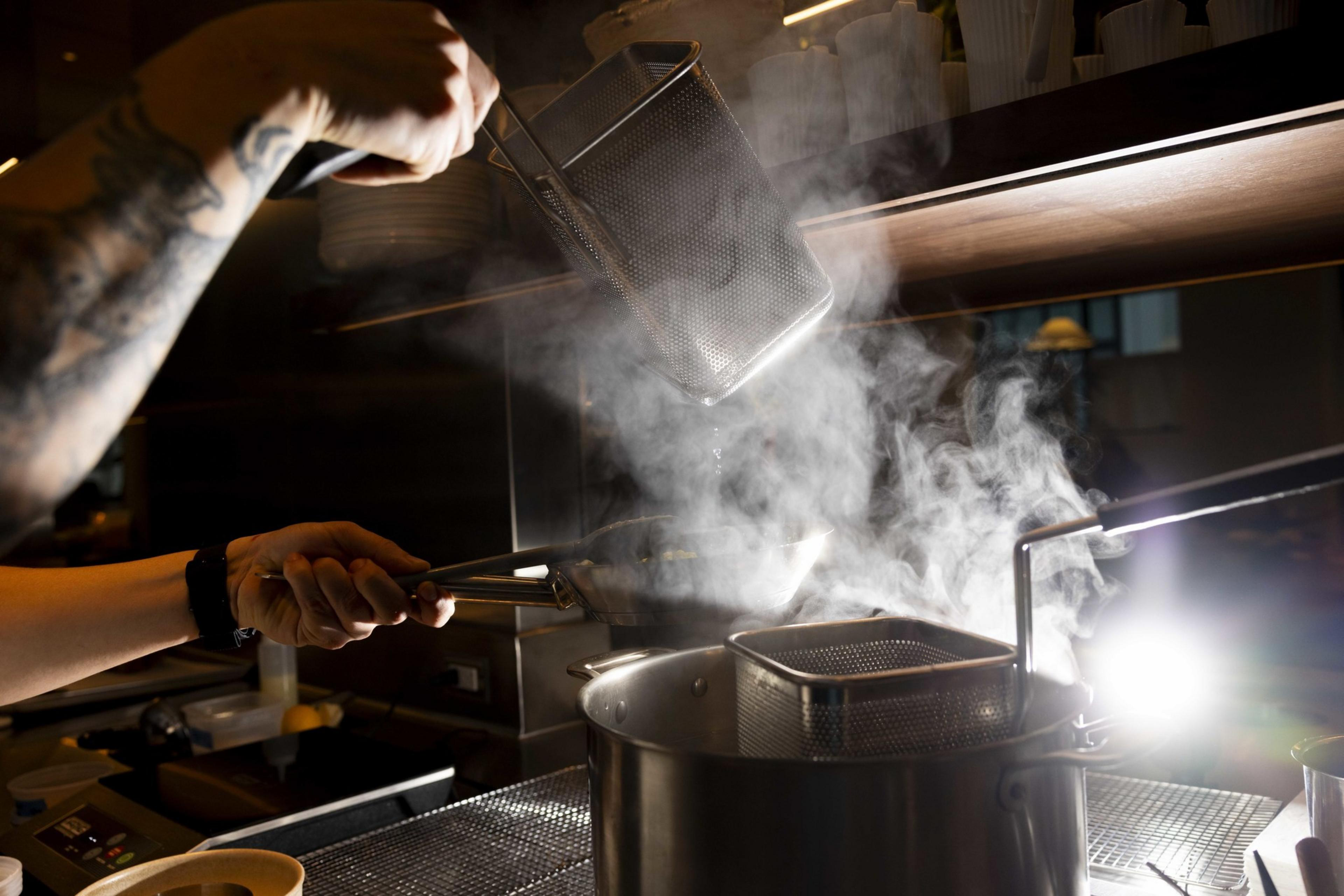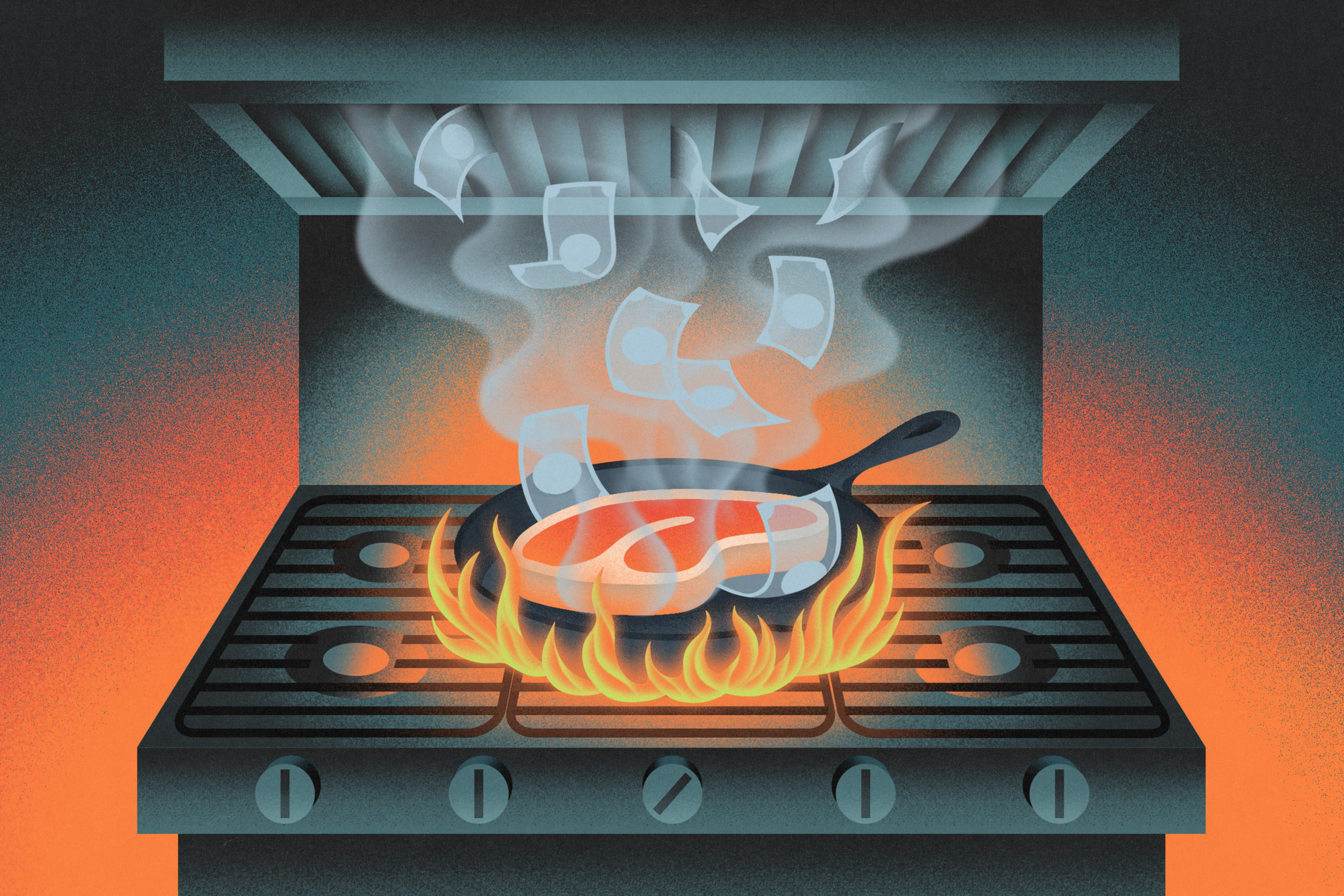In early October, Cafe Sebastian looked nothing like a restaurant. Though the bistro at the foot of the Transamerica Pyramid was preparing to open in a few short weeks, the kitchen was all stainless steel and sawdust. Giving a tour of the space, chef Bradley Kilgore gestured to a plank that would become the pass — where food exits the kitchen to be ferried to tables — and an empty hole where a trio of ovens would eventually sit.
There was one notable omission. Unlike most restaurants, Cafe Sebastian would not have a hood, the exorbitantly expensive and historically crucial piece of equipment that sucks grease, smoke, and fumes from the air above a stove. Without one, the infamous heat of a traditional restaurant kitchen is typically unbearable for even the most hardened cooks. But this would not be one of those “if you can’t stand the heat, stay out of the kitchen” kitchens.


Like a growing number of San Francisco chefs, Kilgore, who estimates he has designed more than 20 restaurant kitchens during decades in the industry, has foregone the trouble and expense of installing a hood. Instead, Cafe Sebastian, which opened in mid-November, relies on equipment and techniques that don’t necessitate one. The decision cuts costs — Kilgore estimates he saved as much as $400,000 by not putting a hood in Cafe Sebastian — and allows for operation in less expensive spaces, often ones that weren’t previously home to restaurants.
The chefs, restaurants, bars, and bakeries changing the flavor of San Francisco
Read the stories
It also challenges chefs to think outside the box. “This is years and years of problem-solving coming to fruition,” Kilgore says. “This is about timing, efficiency, and budget.”
Stuart Brioza’s Anchovy Bar, which opened in 2020, likewise has no hood. The James Beard Award-winning chef sees the absence as a professional challenge. “I like the limitation,” he says. “I think it offers a new creative insight, like a code to crack.” The Anchovy Bar space was previously a 900-square-foot beer and wine bar called Fat Angel. When Brioza got hold of it, he wanted to open a seafood-focused wine bar. Inspired by tiny restaurants he’d seen in Japan, he didn’t even consider installing a hood. Instead, he designed an all-electric kitchen equipped with induction burners, a broiler, and a small convection oven. “There are limitations, for sure,” Brizona acknowledges. “But it’s no less serious of a kitchen.”
When it came to building the menu, Brioza embraced a “gentler” style of cooking — one that doesn’t rely on the smoke-producing Maillard reaction (opens in new tab), a result of high-heat cooking, to produce complex flavors. Instead, he thinks about layering them like a harmony and a melody. Though there are no open flames and smoke-kissed proteins on the Anchovy Bar menu, Brioza packs each plate with bold, punchy flavors. For a dish of pasta with sea urchin and clams, chrysanthemum dashi broth provides a smoky, umami-heavy base over which he adds toasted sesame, garlic, and chiles. The noodles provide texture, and Brioza favors fresh, extruded pasta that cooks faster than dried. That means he can leave a pot of water at a low boil on the induction burner and still cook pasta to order.

At Bar Sprezzatura in the Financial District, which opened two years ago in a 60-story office tower, installing a hood would have required constructing a shaft to the roof, to the tune of “a couple of million dollars,” according to chef Joseph Offner. But even without one, the dinner menu offers hefty entrees, including a $115 wagyu steak and a filet of petrale sole served over creamy cauliflower puree. “I call it a ‘get creative’ kitchen,” Offner says. “Everything tastes the same even without having the same equipment.”
His get-creative approach at Bar Sprezzatura requires some unconventional cooking techniques. The steak, for example, is seasoned, then steamed to a ruby-red medium rare. He finishes it in an oven at a high temperature to get the kind of char usually achieved by searing meat on a grill. Picking the highest-quality ingredients is critical, he explains: “The ingredients will show up more when you’re not manipulating them too much.”
There are other tangible benefits to working in an all-electric kitchen. For one, you’re not inhaling smoke and grease every night on the line. “To me, it’s a healthier kitchen,” Offner says. “That’s one of the things I first noticed: I felt a lot better after I got off work.”
Of course, even chefs without hoods like their toys, and Kilgore is excited to employ a super-powered $20,000 Unox electric oven, which allows him to cook a half chicken, which normally takes three-quarters of an hour, in all of eight minutes. The succulent bird, covered in an everything-bagel-seasoning crust, arrives on a bed of grass-green watercress pesto. Yes, there are things he can’t do, like deep-frying fries. His workaround? Pommes Anna, made by stacking and baking rounds of potatoes in tiny towers.
It’s not a dish often seen on restaurant menus in 2024. But Kilgore’s confident that with the ability to cook at break-neck speeds, no customers will question what equipment he has — or doesn’t have — in the kitchen. They’re too busy enjoying what comes out of it.

